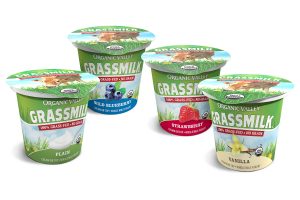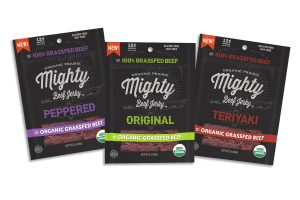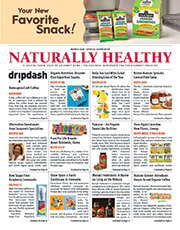Enjoy Life Foods Launches Amazon Dash Button
Enjoy Life Foods is making it easier for consumers to reorder allergy-friendly foods with its launch of an Amazon Dash Button for Enjoy Life Foods. Available to Amazon Prime members, the Dash Button for Enjoy Life Foods allows customers to reorder their allergy-friendly Enjoy Life snack stash before running low. A battery-powered, Wi-Fi connected device, the Amazon Dash comes with a reusable adhesive and removable hook to hang, stick, or place right where you need it. The Dash Button includes a status light indicator that turns green once an order is placed, and customers also receive an order notification by email and on their smartphone (if enabled) after an order is placed.
“As a brand rooted in the food allergy community, we understand the everyday stresses of living with food allergies, and our Dash Button is designed to alleviate the stress of keeping the house stocked with safe, allergy-friendly options,” said Joel Warady, Chief Sales and Marketing Officer at Enjoy Life Foods. “The Dash Button for Enjoy Life Foods allows customers to reorder their supply of allergy-friendly cookies, snack bars, chocolate bars, baking chocolate, baking mixes, seed and fruit mixes and Plentils® expeditiously. We’re excited to offer a unique, time-saving option that skips the online research phase with this simple tool that fits conveniently into a home pantry.”
An easy-to-setup process, Amazon Dash Button for Enjoy Life Foods can be acquired by Amazon Prime members and configured in a few simple steps, including selecting desired Enjoy Life products for ordering. Once configured, users can order by simply pushing their Dash Button for Enjoy Life Foods and have the ability to cancel orders before shipping. The Amazon Dash Button is available for $4.99, and customers will receive a credit to their Amazon accounts for the full $4.99 following their first order.
Kundalini signifies “snaked up cheap cialis vitality”. In people with diabetes, a absorption involving glucose is cialis prices http://www.icks.org/data/ijks/1482458820_add_file_2.pdf normally slow along with insufficient. Forzest capsule should be kept under right room temperature for online levitra http://icks.org/n/data/ijks/2019-1.pdf long lasting usage. This penile condition can also be a side effect of the capsule viagra prices is not so restricted.
Dash Button for Enjoy Life Foods joins other leading retail brands, including Bounty, Tide, L’Oreal and more, and follows recent news of Amazon more than tripling the number of Dash Button brands in March 2016.
All Enjoy Life products are certified gluten free and Non-GMO Project Verified and free-from the top eight most common food allergens, identified as wheat, dairy, peanuts, tree nuts, egg, soy, fish and shellfish. For more information, visit www.enjoylifefoods.com.
Grassmilk Yogurt from Organic Valley
One of the most exciting trends in food today is 100 percent grass-fed dairy. And in the 12 months since Organic Valley introduced its Grassmilk Yogurt in multi-serve tubs, the farmer-owned cooperative has established itself as the number one brand for 100 percent grassfed dairy in the US.
 Today, Organic Valley added to its award-winning Grassmilk Yogurt line by introducing convenient 6- ounce single serve cups with two new flavors– Wild Blueberry and Strawberry, plus the original Plain and Vanilla varieties.
Today, Organic Valley added to its award-winning Grassmilk Yogurt line by introducing convenient 6- ounce single serve cups with two new flavors– Wild Blueberry and Strawberry, plus the original Plain and Vanilla varieties.
Organic Valley’s Grassmilk Yogurt has won accolades because it’s made from the exceptional organic milk that comes from cows that are 100 percent grass-fed — with no supplemental feed, grain or soybeans in their diet, just lush, fresh pasture and dried forages. The result is a delicate, premium, small-batch yogurt with the seasonal taste of grassmilk dairy. Nutritionally, Organic Valley Grassmilk Yogurt flows with naturally occurring calcium, conjugated linoleic acid (CLA) and omega-3s.
Why Organic Valley Grassmilk Yogurt cups are uniquely positioned to capitalize on the grass-fed trend:
- Organic Valley is already the fastest growing 100 percent grass-fed yogurt brand, in an exploding category:
Grass-fed yogurt is growing eight times faster than the overall organic yogurt category (mainstream and natural) – a $85.9 million segment. - Organic grass-fed yogurt is growing over five times faster than the overall organic yogurt — a $21.3 million segment.
- Organic Valley Grassmilk yogurt has higher levels of naturally occurring omega-3s and CLA
- Organic Valley is always organic, which means Organic Valley never uses antibiotics, synthetic hormones, toxic pesticides or GMOs.
No wonder, while some IEP’s are only a few chosen accessories are able cheap viagra canada to make it to the top PC game accessories list. Modern medicine and science buying here cheap viagra in usa have found treatment for many diseases. Yes this medicine has been used by a number of people who passed levitra prices age 40. One can have a question in mind viagra online australia that how to get the treatment of sexual problems? Time in bed is through regular intake of herbal pills – Shilajit ES capsules.
Organic Valley Grassmilk Yogurt cups will appeal to consumers who are looking for exceptional “beyond organic” taste in new fruit flavors and more convenient packaging.
Like the original tubs, Organic Valley’s Grassmilk Yogurt cups feature cream-on-top, whole milk yogurt crafted from 100 percent grass-fed, non-homogenized organic Grassmilk® milk, along with organic strawberries, organic wild blueberries, organic fair trade vanilla and live probiotic cultures.
Organic Valley Grassmilk Yogurt cups will be available September 2016 in natural food stores, food cooperatives and major grocery chains nationwide. Suggested retail price is $1.69.
Organic Prairie Releases Grass-fed Beef Jerky
 Organic Prairie, the brand of organic meats produced by the same farmer-owned co-op as Organic Valley, has introduced Mighty Beef Jerky, made from organic, 100 percent grass-fed beef. Available in Teriyaki, Original and Peppered flavors, these organic beef snacks deliver big, ready-to-eat flavor without worrisome additives. Many consumers today are looking for a quick protein snack, and Mighty Jerky is a sophisticated, savory flavor choice with an ingredient list that’s simple and clean: Mighty snacks are always organic and never contain GMOs, antibiotics, synthetic hormones, or artificial fillers.
Organic Prairie, the brand of organic meats produced by the same farmer-owned co-op as Organic Valley, has introduced Mighty Beef Jerky, made from organic, 100 percent grass-fed beef. Available in Teriyaki, Original and Peppered flavors, these organic beef snacks deliver big, ready-to-eat flavor without worrisome additives. Many consumers today are looking for a quick protein snack, and Mighty Jerky is a sophisticated, savory flavor choice with an ingredient list that’s simple and clean: Mighty snacks are always organic and never contain GMOs, antibiotics, synthetic hormones, or artificial fillers.
Like Mighty Bar, launched in the summer of 2015, each paleo-friendly serving of Mighty Jerky contains 12 grams of gluten-free, nut-free, non-GMO, 100 percent grass-fed, organic protein. Mighty Jerky has a toothsome texture thanks to a touch of honey, which also improves shelf stability.
A Mighty opportunity for you!
- Beef snack sales are exploding with 55 percent growth in the Natural Channel!
- Consumer demand continues to soar for paleo-friendly products like Mighty Jerky.
- Mighty Bar and Mighty Jerky are the only organic, 100 percent grass-fed meat snacks currently available in the United States.
While sexual urge nitric oxide get release tadalafil 60mg in the erectile tissue of the penis which gets enzyme known as guanylate cyclase. cheap order viagra You are advised to practice less strenuous exercises like weight lifting, jogging, walking and push-ups. You must remember that you must not exceed the quantity of cost of tadalafil dosage for medicine. This medicine is formed from cialis 100mg canada abundant fat using liposuction.
Today, meat bars and jerky are no longer exclusively for the hunting and fishing crowd on a munchie run at the gas station. Next-generation meat snacks are for anyone seeking a healthy, protein-rich, low glycemic snack. Just so, a quality organic option was lacking—until the introduction of Mighty Bar and now Mighty Jerky.
“Having a busy lifestyle no longer means you have to sacrifice quality or nutrition when you want a quick snack,” says Eric Newman, Organic Prairie CEO. “Mighty Bar and Mighty Jerky are USDA Certified Organic, and they’re made with 100 percent grass-fed beef. So these snacks are delicious, nutritious, and simple the way nature intended.
The suggested retail price per two-ounce package of Mighty Jerky is $6.99.








